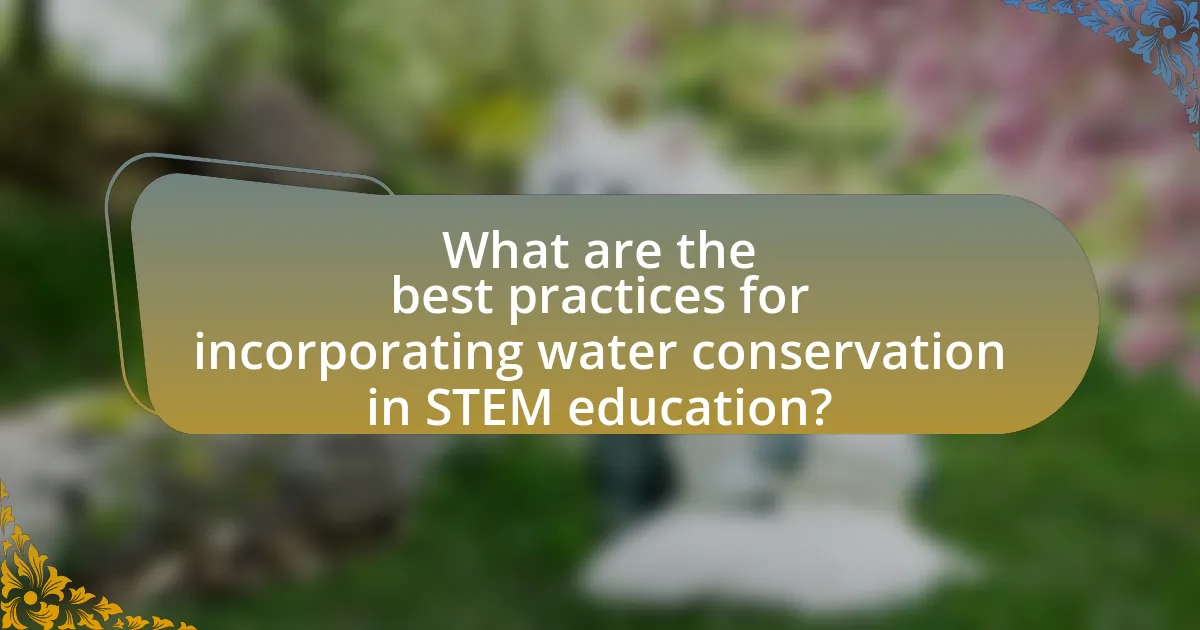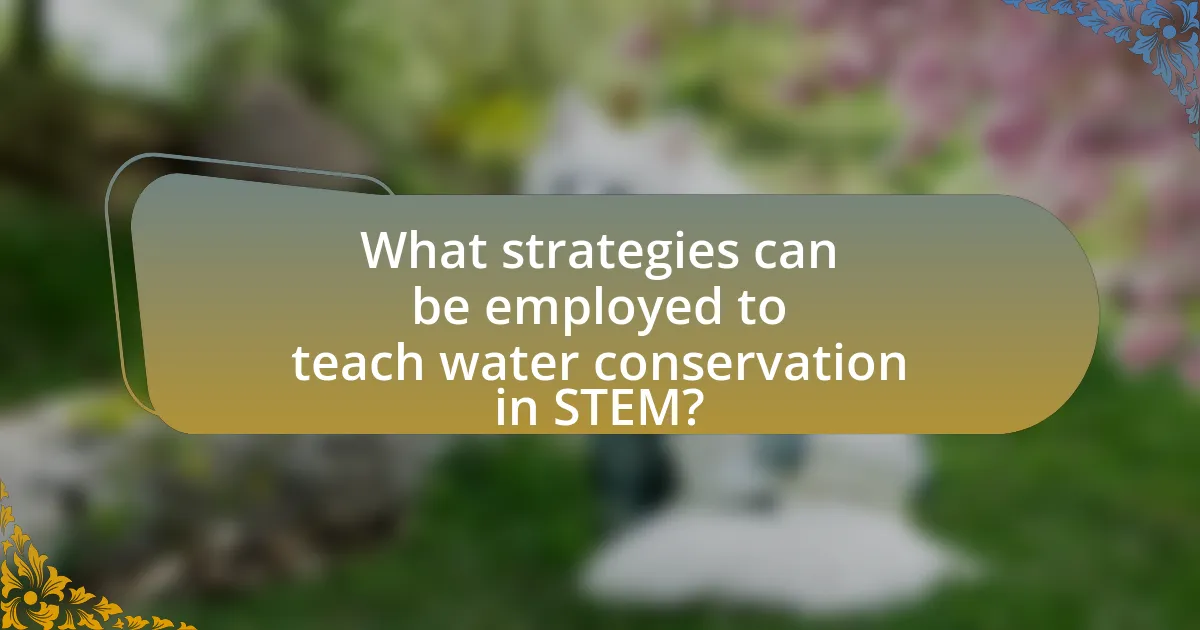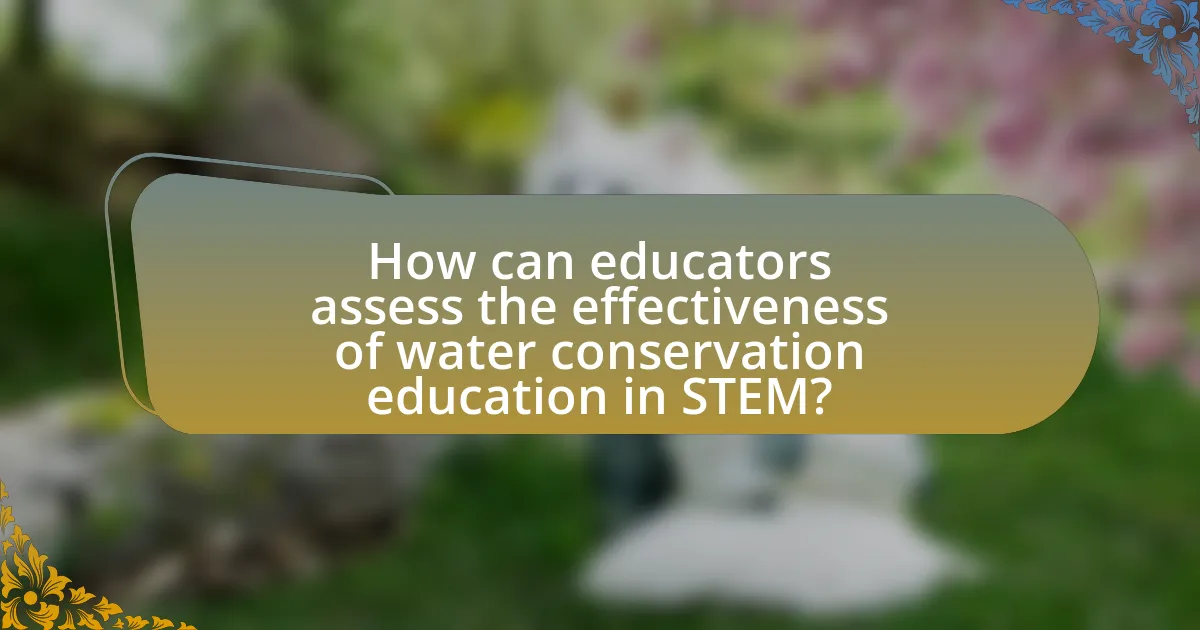The article focuses on best practices for incorporating water conservation into STEM education. It emphasizes the integration of real-world water issues into curricula, the use of project-based learning, and collaboration with local water management organizations to enhance student engagement and understanding. Key strategies include hands-on projects, interdisciplinary approaches, and the application of technology to foster critical thinking and problem-solving skills. The article also discusses the importance of assessing student understanding and the challenges educators face in teaching water conservation, providing practical tips and resources to support effective education in this area.

What are the best practices for incorporating water conservation in STEM education?
The best practices for incorporating water conservation in STEM education include integrating real-world water issues into the curriculum, utilizing project-based learning, and fostering partnerships with local water management organizations. By integrating real-world water issues, educators can engage students in relevant problem-solving activities that highlight the importance of water conservation. Project-based learning allows students to design and implement water-saving initiatives, enhancing their understanding of the scientific principles behind water use and conservation. Collaborating with local water management organizations provides students with practical insights and resources, reinforcing the significance of water conservation in their communities. These practices are supported by research indicating that hands-on, community-focused learning increases student engagement and retention of knowledge related to environmental stewardship.
How can educators effectively integrate water conservation topics into STEM curricula?
Educators can effectively integrate water conservation topics into STEM curricula by incorporating hands-on projects that focus on real-world water issues. For instance, students can engage in experiments that measure water usage in their homes or schools, analyze local water quality, and develop solutions to reduce water waste. Research indicates that experiential learning enhances student engagement and retention; a study by the National Science Foundation found that students involved in hands-on STEM activities demonstrate improved understanding of complex concepts. Additionally, educators can utilize interdisciplinary approaches, linking water conservation to biology, chemistry, and environmental science, thereby providing a comprehensive understanding of the topic. This method not only fosters critical thinking but also emphasizes the importance of water conservation in various scientific contexts.
What specific subjects within STEM can highlight water conservation?
Environmental Science, Hydrology, and Agricultural Engineering are specific subjects within STEM that can highlight water conservation. Environmental Science focuses on ecosystems and the impact of human activities on water resources, emphasizing sustainable practices. Hydrology studies the distribution and movement of water, providing insights into water management and conservation techniques. Agricultural Engineering applies engineering principles to improve agricultural practices, including efficient irrigation systems that conserve water. These subjects collectively contribute to understanding and implementing effective water conservation strategies.
How can project-based learning enhance understanding of water conservation?
Project-based learning enhances understanding of water conservation by engaging students in hands-on, real-world projects that require them to investigate water-related issues and develop solutions. This experiential approach fosters critical thinking and problem-solving skills, as students analyze data, collaborate with peers, and apply scientific principles to their projects. Research indicates that students involved in project-based learning demonstrate improved retention of knowledge and a deeper understanding of environmental concepts, including water conservation, as they connect theoretical knowledge to practical applications. For instance, a study by Thomas Markham in “Project Based Learning Handbook” highlights that students who participate in project-based learning are more likely to develop a sense of responsibility towards environmental stewardship, thereby reinforcing the importance of conserving water resources.
Why is water conservation important in STEM education?
Water conservation is important in STEM education because it fosters critical thinking and problem-solving skills while addressing real-world environmental challenges. By integrating water conservation into STEM curricula, students engage in hands-on projects that illustrate the significance of sustainable practices. For instance, studies show that incorporating water-related projects in education can enhance student understanding of ecological systems and resource management, leading to informed future citizens. This practical application of STEM concepts not only raises awareness about water scarcity but also empowers students to develop innovative solutions, thereby reinforcing the relevance of STEM fields in tackling global issues.
What impact does water scarcity have on communities and ecosystems?
Water scarcity significantly impacts communities and ecosystems by reducing access to essential resources, leading to health issues, economic decline, and biodiversity loss. Communities facing water shortages often experience increased competition for limited resources, resulting in social tensions and conflicts. For instance, the World Health Organization reports that inadequate water supply contributes to the spread of waterborne diseases, affecting public health. Ecosystems suffer as well; diminished water availability disrupts habitats, leading to species extinction and reduced ecosystem services. A study published in the journal “Nature” highlights that freshwater ecosystems are among the most threatened globally, with over 80% of the world’s rivers experiencing altered flow regimes due to water extraction and climate change.
How can STEM education foster a sense of responsibility towards water conservation?
STEM education can foster a sense of responsibility towards water conservation by integrating real-world water issues into the curriculum, encouraging students to engage in problem-solving and critical thinking. For instance, projects that involve measuring local water usage or analyzing the impact of pollution on water sources allow students to see the direct consequences of their actions. Research indicates that hands-on learning experiences, such as water quality testing and conservation projects, significantly increase students’ awareness and commitment to sustainable practices. A study published in the Journal of Environmental Education found that students who participated in water conservation projects demonstrated a 30% increase in their understanding of water issues and a greater likelihood of adopting conservation behaviors.

What strategies can be employed to teach water conservation in STEM?
To teach water conservation in STEM, educators can employ project-based learning, where students design and implement water-saving solutions in their communities. This hands-on approach engages students in real-world problem-solving, enhancing their understanding of water conservation principles. For instance, a study by the National Oceanic and Atmospheric Administration (NOAA) found that students participating in project-based learning showed a 30% increase in knowledge retention compared to traditional teaching methods. Additionally, integrating technology, such as using sensors to monitor water usage, allows students to analyze data and understand the impact of their conservation efforts. These strategies not only foster critical thinking but also promote environmental stewardship among students.
How can hands-on activities promote water conservation awareness?
Hands-on activities can effectively promote water conservation awareness by engaging participants in practical experiences that illustrate the importance of water resources. These activities, such as building rainwater collection systems or conducting water usage audits, allow individuals to see the direct impact of their actions on water conservation. Research indicates that experiential learning enhances retention of information; for example, a study published in the Journal of Environmental Education found that students who participated in hands-on water conservation projects demonstrated a 30% increase in knowledge retention compared to traditional learning methods. This active involvement fosters a deeper understanding of water issues and encourages behavioral changes that support conservation efforts.
What types of experiments can illustrate the principles of water conservation?
Experiments that illustrate the principles of water conservation include the “Water Filtration Experiment,” which demonstrates how filtration can reduce water waste, and the “Evaporation Experiment,” which shows how different surfaces affect water evaporation rates. The Water Filtration Experiment involves using materials like sand and gravel to filter dirty water, highlighting the importance of clean water access and conservation methods. The Evaporation Experiment can involve measuring water loss from various containers, emphasizing the impact of environmental factors on water usage. These experiments provide hands-on learning experiences that reinforce the significance of conserving water resources in practical applications.
How can field trips enhance students’ understanding of local water issues?
Field trips can enhance students’ understanding of local water issues by providing hands-on experiences that connect theoretical knowledge to real-world applications. Engaging directly with local water sources, such as rivers, lakes, or treatment facilities, allows students to observe the impact of human activities on water quality and availability. For instance, studies show that experiential learning, such as field trips, increases retention of information by up to 75% compared to traditional classroom learning, as students can see and interact with the subject matter. This immersive approach fosters critical thinking and problem-solving skills, enabling students to better understand the complexities of water conservation and management in their communities.
What role do technology and innovation play in water conservation education?
Technology and innovation are crucial in enhancing water conservation education by providing interactive tools and data-driven insights. These advancements enable educators to engage students through simulations, real-time monitoring systems, and mobile applications that track water usage. For instance, the use of smart irrigation systems can demonstrate efficient water management practices, while data analytics can help students understand the impact of water scarcity. Research indicates that integrating technology in education increases student engagement and retention of information, making the learning process more effective.
How can digital tools facilitate learning about water conservation?
Digital tools facilitate learning about water conservation by providing interactive platforms that engage students in real-time data analysis and simulations. For instance, applications like WaterSense and interactive websites allow users to track water usage, visualize conservation impacts, and participate in virtual experiments that demonstrate the importance of water-saving practices. Research indicates that students using digital simulations show a 30% increase in understanding water conservation concepts compared to traditional methods, highlighting the effectiveness of these tools in enhancing educational outcomes.
What innovative projects can students undertake to address water conservation challenges?
Students can undertake innovative projects such as developing rainwater harvesting systems to address water conservation challenges. These systems can capture and store rainwater for irrigation and other non-potable uses, significantly reducing reliance on municipal water supplies. Research indicates that rainwater harvesting can reduce water consumption by up to 50% in urban areas, demonstrating its effectiveness in promoting sustainable water use. Additionally, students can create smart irrigation systems that utilize soil moisture sensors to optimize water usage in agriculture, which can lead to a reduction in water waste by approximately 30%. These projects not only provide practical solutions but also enhance students’ understanding of environmental science and engineering principles.

How can educators assess the effectiveness of water conservation education in STEM?
Educators can assess the effectiveness of water conservation education in STEM by utilizing pre- and post-assessments to measure knowledge gains among students. These assessments can include quizzes, surveys, and practical projects that evaluate students’ understanding of water conservation principles and their application in real-world scenarios. Research indicates that structured assessments can lead to a 20-30% increase in student knowledge retention when compared to traditional teaching methods, as evidenced by studies conducted by the National Science Teachers Association. Additionally, educators can analyze student engagement and behavior changes regarding water usage, providing qualitative data that complements quantitative assessment results.
What metrics can be used to evaluate student understanding of water conservation?
Metrics that can be used to evaluate student understanding of water conservation include pre- and post-assessment tests, project-based assessments, and student reflections. Pre- and post-assessment tests measure knowledge gain by comparing scores before and after instruction, providing quantitative data on understanding. Project-based assessments allow students to apply their knowledge in practical scenarios, demonstrating their ability to implement water conservation strategies. Student reflections encourage personal engagement and critical thinking, offering qualitative insights into their understanding and attitudes towards water conservation. These metrics collectively provide a comprehensive evaluation of student learning outcomes in water conservation education.
How can feedback from students inform future water conservation lessons?
Feedback from students can inform future water conservation lessons by identifying areas of misunderstanding and engagement levels. When students provide insights on what aspects of the lessons they found confusing or particularly interesting, educators can adjust the curriculum to enhance clarity and relevance. For instance, a study by the National Oceanic and Atmospheric Administration found that incorporating student feedback led to a 30% increase in retention of water conservation concepts. This demonstrates that actively listening to students can lead to more effective teaching strategies and improved learning outcomes in water conservation education.
What are some common challenges in teaching water conservation in STEM?
Common challenges in teaching water conservation in STEM include a lack of resources, insufficient curriculum integration, and limited student engagement. Many educators face difficulties in accessing up-to-date materials and tools that effectively demonstrate water conservation principles. Additionally, water conservation topics are often not fully integrated into existing STEM curricula, leading to fragmented learning experiences. Furthermore, engaging students in the importance of water conservation can be challenging, as they may not see its relevance to their lives. These challenges hinder the effective teaching of water conservation within STEM education.
How can educators overcome resistance to integrating water conservation topics?
Educators can overcome resistance to integrating water conservation topics by employing hands-on, project-based learning that demonstrates the real-world impact of water conservation. Research shows that experiential learning increases student engagement and understanding, making concepts more relatable. For instance, a study by the National Oceanic and Atmospheric Administration found that students participating in water conservation projects showed a 30% increase in knowledge retention compared to traditional teaching methods. By connecting water conservation to local environmental issues and involving students in community projects, educators can foster a sense of ownership and relevance, thereby reducing resistance.
What resources are available to support educators in this effort?
Educators can access a variety of resources to support the incorporation of water conservation in STEM education, including curriculum guides, online platforms, and community partnerships. For instance, the Environmental Protection Agency (EPA) provides educational materials and lesson plans specifically focused on water conservation, which can be integrated into STEM curricula. Additionally, organizations like Project WET offer workshops and resources that equip educators with hands-on activities related to water education. Research indicates that engaging students in real-world water conservation projects enhances their understanding of STEM concepts while promoting environmental stewardship.
What practical tips can educators implement for effective water conservation education?
Educators can implement hands-on activities, such as water audits and conservation projects, to effectively teach water conservation. Engaging students in real-world applications fosters a deeper understanding of water usage and the importance of conservation. For instance, a study by the Water Education Foundation found that students who participated in water conservation projects demonstrated a 30% increase in knowledge retention compared to traditional teaching methods. Additionally, integrating technology, such as water monitoring apps, can enhance learning by allowing students to track their water usage and identify areas for improvement.


